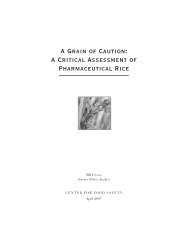a four-fold rise - Center for Food Safety
a four-fold rise - Center for Food Safety
a four-fold rise - Center for Food Safety
You also want an ePaper? Increase the reach of your titles
YUMPU automatically turns print PDFs into web optimized ePapers that Google loves.
<strong>Center</strong> <strong>for</strong> <strong>Food</strong> <strong>Safety</strong> – Science Comments – FG72 Soybean <br />
47 <br />
HR weeds has increased by 400% over just the three years from November 2007 to November <br />
2010 (Freese 2010, p. 15). There are at least 12 biotypes of weeds resistant to glyphosate and <br />
one or more other herbicide families in the U.S. (11) and Canada (1) that are attributable to RR <br />
crop systems, all but one having emerged since 2005 (ISHRW GR Weeds 4/22/12). <br />
The progressive acquisition of resistances to different herbicide classes has the insidious effect <br />
of accelerating evolution of resistance to those ever fewer herbicides that remain effective, <br />
such as isoxaflutole. This is well-‐expressed by Bernards et al. (2012) with reference to <br />
multiple-‐herbicide-‐resistant waterhemp, though it applies more generally: <br />
The accumulation of multiple-‐resistance genes within populations and even <br />
within individual plants is of particular concern. This resistance stacking limits <br />
chemical options <strong>for</strong> managing waterhemp and, where weed management <br />
depends primarily on chemical weed control, results in additional selection <br />
pressure <strong>for</strong> the evolution of resistance to the few herbicides that are still <br />
effective. <br />
There is already evidence of isoxaflutole resistance evolving in common waterhemp already <br />
resistant to atrazine, as discussed above; raising the spector that this will also occur with three <br />
other especially problematic species of weeds: horseweed, Palmer amaranth and kochia, and <br />
in more populations of common waterhemp. <br />
i. Horseweed <br />
Horseweed, or marestail, is the most prevalent GR weed. First discovered in 2000 in Delaware, <br />
GR horseweed has emerged in just over a decade to infest up to 8.4 million acres in 20 states <br />
(CFS GR Weed List 2012 13 ), up from 3.3 million acres in 16 states in February 2009 (Benbrook <br />
2009a, p. 35). It is particularly prevalent in Tennessee, Kansas and Illinois, with populations <br />
infesting up to 5 million, 2 million and 1 million acres, respectively. GR horseweed in <br />
Mississippi is also resistant to paraquat, the first time multiple resistance to these two <br />
herbicides has been documented, while Ohio has glyphosate/ALS inhibitor-‐resistant 14 <br />
horseweed. <br />
Weed scientists regard GR horseweed as a “worst-‐case scenario” in RR cropping systems <br />
because this weed is well adapted to no-‐tillage planting systems popular among GR crop <br />
growers. It also produces up to 200,000 seeds per plant, and its seeds can disperse extremely <br />
long distances in the wind (Owen 2008), which may partly explain the prevalence of GR <br />
horseweed. <br />
13 Consult this chart <strong>for</strong> data in the following discussion. It should also be noted that these acreage-infested<br />
estimates are highly conservative, in view of the underreporting in the ISHRW system, as <br />
discussed above. <br />
14 CFS suspects that GR weeds that are also resistant to ALS inhibitor herbicides are greatly <br />
underreported by ISHRW; this is certainly the case with common waterhemp (see discussion below).







